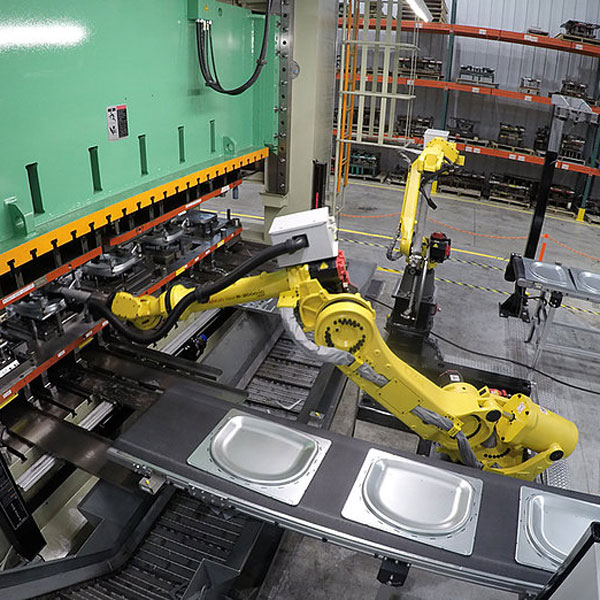Advanced Metal Stamping Approaches for Accuracy Production
Advanced Metal Stamping Approaches for Accuracy Production
Blog Article
Metal Marking Technologies: Elevating Manufacturing Processes for Superior Results
In the world of making procedures, metal marking has long been a cornerstone technique for generating an array of precision components. With the ruthless march of technological innovation, the landscape of metal stamping is going through a substantial transformation.
Evolution of Metal Marking Techniques

In addition, advancements in product science have caused the development of high-strength alloys that can now be perfectly marked right into intricate shapes, catering to a wider variety of commercial applications. The combination of robotics and artificial knowledge has better optimized the stamping procedure by boosting rate and precision while minimizing the risk of human mistake.

Impact of Advanced Products
Have advanced products changed steel stamping procedures significantly in the manufacturing sector? By utilizing products such as high-strength alloys, advanced composites, and ingenious coverings, metal marking processes can currently produce parts that are lighter, more powerful, and extra durable than ever in the past.
These sophisticated materials provide superior mechanical homes, deterioration resistance, and thermal security, allowing manufacturers to meet the demands of contemporary sectors such as aerospace, auto, and electronics. Additionally, using innovative materials in metal marking has actually helped with the manufacturing of complicated geometries and elaborate designs that were formerly unattainable via conventional methods.
In addition, the implementation of innovative products has brought about decreased product waste, lower production expenses, and much shorter lead times, making steel stamping processes more economical and sustainable. As modern technology proceeds to development, the effect of sophisticated materials on metal marking procedures is anticipated to drive further technology and enhance the competitiveness of manufacturers in the global market.
Automation in Metal Stamping
The development of metal marking processes driven by the combination of advanced products has actually established the stage for considerable advancements in automation within the manufacturing sector. Automation in metal stamping has actually reinvented production procedures, boosting efficiency, precision, and total outcome top quality. Via the utilization of robotics, sensors, and computer-controlled systems, jobs that were as soon as manual and taxing can now be implemented with exceptional speed and accuracy.
Automation in steel stamping not just accelerates production prices however additionally guarantees uniformity in the manufacturing process. By reducing human intervention, the risk of errors is considerably lowered, resulting in higher levels of item harmony and integrity. In addition, automation allows suppliers to undertake intricate stamping tasks that would be tough or not practical to attain manually.
Moreover, automation in metal marking adds to a safer working environment by decreasing the demand for workers to participate in repetitive or dangerous jobs - Metal Stamping. This Get More Info shift in the direction of automation not just enhances performance but likewise leads the way for the future of manufacturing, where innovation plays a main role in driving operational quality
Top Quality Control and Evaluation Solutions
With a concentrate on accuracy and integrity, high quality control and assessment systems play a crucial function in making certain item quality in steel stamping procedures. These systems are developed to keep track of every stage of production, from product evaluation to the final product, to guarantee that all components meet the needed standards. By carrying out innovative modern technologies such as optical examination systems, coordinate gauging equipments (CMM), and automated determining equipment, producers can discover even the smallest deviations in dimensions, surface area quality, and overall integrity of stamped components.

Sustainability Practices in Metal Stamping
Building upon the structure of accuracy and reliability established through quality control and evaluation systems, the integration of sustainable practices in steel marking processes is progressively becoming a centerpiece for manufacturers looking for to decrease ecological effect and enhance resource application. Sustainability techniques in metal stamping include a series of initiatives targeted at minimizing waste generation, energy consumption, and greenhouse gas exhausts throughout the visit this site right here production procedure.
One key aspect of sustainability in steel stamping is the fostering of eco-friendly materials and innovations that promote recyclability and waste decrease. By utilizing recycled materials and applying energy-efficient equipment, producers can reduce their carbon footprint and add to a much more sustainable manufacturing cycle. Additionally, maximizing manufacturing procedures to minimize product waste and energy use not only profits the atmosphere however also causes cost financial savings for organizations over time.
Additionally, the implementation of lasting practices in metal stamping can improve brand online reputation and interest environmentally mindful consumers. As sustainability continues to obtain significance in the production market, integrating green efforts right into steel stamping procedures is essential for long-lasting success and competition out there.
Verdict
To conclude, metal marking techniques have dramatically evolved in time, including innovative materials and automation to enhance making procedures. Quality assurance and inspection systems play a vital role in making certain superior results, while sustainability techniques explanation are increasingly being executed to decrease ecological influence. These innovations in metal marking have actually reinvented the sector, leading to much more lasting and effective manufacturing techniques for different markets.
Metal stamping, once a guidebook and labor-intensive procedure, has actually changed right into a very automated and innovative technique of shaping metal sheets into various forms and designs.Have sophisticated products changed metal marking processes considerably in the production industry? By making use of materials such as high-strength alloys, progressed compounds, and cutting-edge coatings, metal stamping procedures can currently create components that are lighter, stronger, and more durable than ever in the past.
The evolution of metal marking procedures driven by the combination of advanced products has actually established the stage for significant improvements in automation within the manufacturing industry.In conclusion, steel stamping techniques have actually substantially developed over time, incorporating sophisticated materials and automation to enhance manufacturing procedures.
Report this page